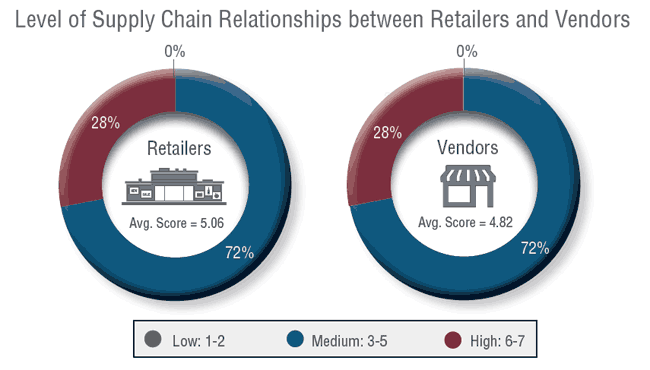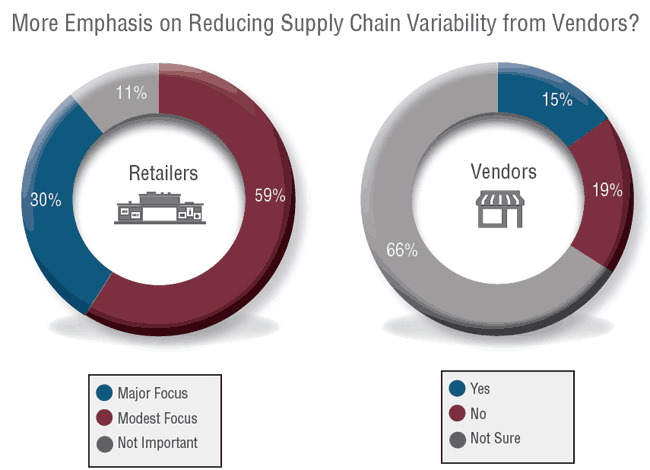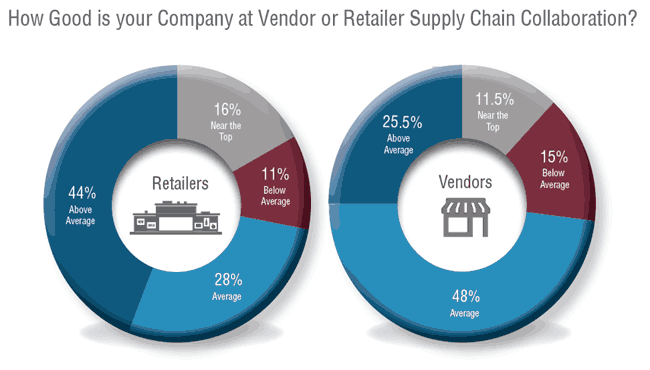Last week I did part I of a two-part summary of SCDigest's excellent new benchmark report on The State of Retail-Vendor Supply Chain Relationships 2018, based on a major survey we did in late 2017. It was the second in what we plan to be on on-going series of such benchmark studies on this topic.
The report is based on a survey of SCDigest readers, along with support from RVCF (Retail Value Chain Federation), which encouraged its members to participate. In addition, the research was supported by our friends at Compliance Networks, a well-known provider of retail vendor performance management solutions.
Gilmore Says.... |
 |
Over the last 18 months or so, Walmart and Target both have recently announced programs to reduce vendor variability |
 |
What do you say? |
|
| Click here to send us your comments |
| |
|
|
|
All told, SCDigest received survey responses from 44 retailers, about 165 consumer goods manufacturers, and 60 from the "other" category.
That first column, which you can find here, was mostly an overview of the incredible changes taking place in this value chain, the most prominent and important in the industry. I then also included a couple of graphs and some interesting commentary from survey takers on the always controversial topic of retail chargebacks. Let's just say neither retailers or vendors see reductions in chargeback levels any time soon.
This week I am back with a look at results from other areas of retailer-vendor supply chain relationships.
The good news is both sides say that their relationships Are getting slightly better – or at least not deteriorating. We asking both retailers and vendors to rate their current relations with vendors or retailers from a supply chain perspective on a scale of 1 to 7, with 1 being the worst and 7 being the highest. We then took those scores and grouped them, in an approach we use throughout this report: 1-2 categorized as low, 3 to 5 medium, and 6 or 7 high.
As can be seen in the chart below, the results were almost identical, with 72% of both retailers and vendors indicating they had medium levels of supply chain relationships, and 28% claiming high levels, while no retailer or vendor said they had poor supply chain relationships.

The average score for retailers was 5.06, a bit above the 2016 benchmark average of 4.72, while the average vendor score was of 4.82 was almost identical to the average of 4.85 in the prior survey.
"On-time, on-full continues to be challenging," one vendor commented. "Not all retailers apply same metrics."
"Good relations but not great compliance," interestingly said one retailer. Added another: "Would say things are fairly status quo, which means OK but not great in this time of immense change."
You can certainly say that again.
To my mind very importantly, over the last 18 months or so, Walmart and Target both have recently announced programs to reduce vendor variability, an area where frankly most retailers historically have put little real focus, other than collecting chargebacks. Grocers HEB and Kroger have also launched similar initiatives, in a first for the grocery sector.
Is this a real overall trend in the consumer goods to retail supply chain? An emerging one, our survey data says. A significant 30% or retailers say reducing vendor-caused supply chain variability is a major focus area, with another 59% saying it is at least a modest focus.
On the vendor side, 15% see variability as a major retail focus, though the vast majority (66%) say they aren't sure yet, as shown in the graphic below.

The comment from one vendor probably has it right: "With Walmart - absolutely. If they are successful, others will follow."
Commented one retailer that sees lots of opportunity on this area: "There is no question retailers are relatively unfocused on the impact of supply chain variability, and there is much to be gained here."
Lastly, we also asked both retailers and vendors to rate their overall level of supply chain collaboration capabilities.
As can be seen in the chart below, 16% of retailers believe they are "near the top" in terms of collaborative skill and practices. Interestingly that was up from 0% in the previous study.
Another 44% of retailers believe they are above average. Only 11% believe their collaboration is below average.

A similar story occurs on the vendor side, with 11.5% believing they are near the top of the collaboration hill. But only 25% believe they are above average, while a significant 15% say they are below average.
I wish we had asked more questions about what each side can do to improve collaboration. Will do that in the 2020 survey I promise.
There is so much more, but I am out of space. This is really good data, and especially interesting are the many comments from survey takers. You can download the report here.
What's your view on the state of retail-vendor relations 2018? How are macro-trends impacting that? What are your thoughts on this data? Let us know your thought at the Feedback section below.
Your Comments/Feedback
|